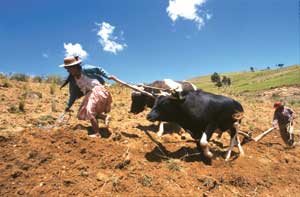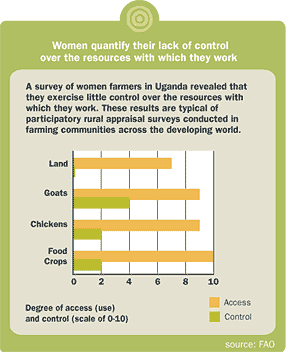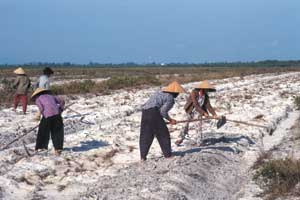


 |
Preserving biodiversity, including plant and animal genetic resources, is now widely recognized as essential to achieving food security. To protect themselves against crop failure, animal losses and malnutrition, men and women subsistence farmers have each developed different expertise and knowledge about the local environment, plant and animal species and their products and uses. This gender-differentiated local knowledge plays a decisive role in the conservation, management and improvement of genetic resources for food and agriculture
As food producers, rural women and men have a stake in the preservation of natural resources and in environmentally sustainable development. This stake depends on such factors as the division of labour between women and men in using and managing resources, and the access to and control over those
resources. The gender labour division is constantly evolving over time, and differs from place to place. Men and women have precious but different knowledge regarding local agricultural conditions and methods. Men generally do the large-scale cropping of commercial crops, especially when it is highly mechanized. Women usually work on a smaller scale, employing traditional tools and techniques to grow food for their families and the local market.
Access to and control over land concern both rural women and rural men, although women are at a disadvantage, mainly because of customary practices and laws that limit their access to resources. Without secure land rights, farmers have little or no access to credit, rural organizations and other agricultural inputs and services. Furthermore, they lack incentives to maintain the quality of soil and resources.
 |
Land and water resources form the basis of all farming systems, and their preservation is crucial to sustained and improved food production. Women farmers take a leading role in conserving soil fertility. In fields where cash crops are grown, women are often responsible for applying fertilizer and for cultivating the crops. In the smaller plots and home gardens where women grow food for consumption at home, they usually employ a wide variety of techniques to conserve and improve soil fertility, including intercropping (planting several different crops in a field at one time), crop rotation (planting a field with different successive crops), fallowing (leaving fields uncultivated for at least a season) and mulching (spreading organic material on the soil around plants to avoid water evaporation). Women farmers tend to use and perfect traditional cropping methods that protect natural resources.
There is a shortage of good-quality agricultural land, and access to land concerns both rural women and rural men because it is essential to improving agricultural productivity and to household well-being. However, systematic differences between women's and men's land tenure rights continue, contributing to structural inequality and to poverty for women. In many countries and communities, women are blocked by tradition or law from owning land. Even a woman's right to work small plots and home gardens must often be granted by her husband or requested from male village elders. Insecure land tenure reduces farmers' incentives to maintain soil quality because they have no permanent rights to the land. Without legal ownership to land that can be used as collateral, men and women producers frequently cannot obtain the credit that is needed to make land and water improvements, such as irrigation and drainage systems and terracing.
Women also suffer from inequalities in rights and access to water. Although they represent the majority of the developing world's farmers, and are also usually responsible for providing water for domestic use and agriculture, tradition often excludes women from managing water. In order to enhance their participation, FAO - in conjunction with the United Nations Fund for International Partnerships - is embarking on a three-year project to strengthen women's ability to manage irrigation and water resources in Cambodia, Nepal and Zambia. With the assistance of local non-governmental organizations (NGOs), women in these countries are learning how to be more fully involved in water management decisions and actions, thereby improving food security for their families and communities.
All too often, membership in water user associations and participation in training on water management and irrigation are extended only to male heads of holding. Because women are frequently excluded, both their needs and their knowledge are neglected, even though women are often the first to adopt technologies effectively and spontaneously, such as hillside terracing, contour bunds and vegetable hedges.
Gender, biodiversity and local knowledge systems (LinKS) Since its launch in 1998, this project has initiated research, training and communication activities to make sure that men's and women's local knowledge is recognized, valued and applied to development projects, research and policy. One major focus of LinKS is on local crop varieties that have been developed over many generations. Traditionally, women are responsible for selecting and improving local crops. They do this by choosing such characteristics as high yields, resistance to pests and diseases, taste, cookability and storage properties. LinKS is working in a variety of ways to collect and document women's knowledge of local crops and to ensure that it is appreciated as a valuable resource for development. In the United Republic of Tanzania, for example, LinKS is exploring the use of rural seed fairs to increase the recognition and exchange of men and women farmers' knowledge of the diversity of seeds, plant material and livestock breeds. Local farmers also have a great deal of knowledge about the use of organic fertilizers and pesticides, post-harvest and processing methods and the treatment of livestock diseases. A traditional system of crop rotation from the Ruvuma Region of Tanzania has been shown to be an effective way of minimizing soil erosion in mountainous areas.
|
Crop diversity is the reservoir of genetic variation that can be tapped to increase productivity, resist pests and diseases, adapt to different climate and soil conditions and fit the taste preferences and nutrition needs of consumers. All farmers depend on it. Smallholders and the rural poor, the very people who have benefited least from modern, high-yielding varieties, have played a leading role in creating and conserving this invaluable heritage. Men and women smallholders frequently cultivate different crops, with men focusing on staples and cash crops while women grow legumes, vegetables and other foods for family consumption. Where this is the case, men and women farmers have distinct and valuable expertise and knowledge about crop varieties and their suitability for local conditions, customs and tastes. Efforts to conserve, manage and improve crop diversity and productivity can only succeed if both men's and women's roles are recognized.
In many farming communities, women are the main custodians of knowledge about crop varieties. In some regions of sub-Saharan Africa, women may cultivate as many as 120 different plants alongside the cash crops that are managed by men. Researchers in Thailand identified 230 different plant species in home gardens in a single village. Many of the plants had been rescued from a neighbouring forest before it was cleared.
Women's leading role in selecting and cultivating crop varieties also makes it essential to involve both women and men in efforts to introduce new and improved seeds for food crops. Today, breeders, researchers and extension workers recognize that communities are much more likely to adopt seeds that have been tested and approved by both women and men farmers.
Because women often grow different crops and perform most of the work of cultivating the fields, they also possess valuable knowledge about crop pests and ways of combating them. Empowered by such participatory techniques as farmer field schools, women have frequently taken the lead in adopting integrated pest management (IPM) methods (see Box on Farmer field schools in Cambodia)
Planning for action The FAO Gender and Development Plan of Action includes commitments from FAO Divisions to promote gender equality in access to, control over and management of natural resources. Many of these commitments are based on the recognition that women have long played a leading role in using and managing fields and forests, crops, fish and livestock. Gender issues will be mainstreamed to support women with information, training and technology that will help them to perform these tasks more productively and to participate equally in decision-making. Land and water
Plants
Animal resources
Forestry
Fisheries
|
Worldwide, more than 600 million rural people depend on livestock for a significant part of their livelihoods. The importance of animal production tends to be even greater among poor farming families and communities than it is among wealthier farmers. As in other agricultural sectors, men and women usually have distinct roles in managing livestock. Commonly, men own cattle, buffalo and other large animals, using them to work the fields. But women often do most of the work of feeding, caring and milking these animals. In addition, women frequently have sole responsibility for raising smaller, short-cycled animals, such as goats, pigs and poultry. Women also take a leading role in breeding livestock, often maintaining and strengthening traditional breeds that are threatened by extinction.
 |
In addition to providing food for their families, women's livestock production often represents one of the few sources of income over which they have complete control. Studies show that, because poor, rural women spend almost all of their income on food for their families, increasing poultry and small animal production does more to improve the diets of poor people than expanding cattle herds does.
With their differentiated roles in owning and caring for livestock, men and women have very different knowledge and needs. However, women's contribution to livestock production is often overlooked, as are their roles in animal breeding and in processing and marketing livestock products. Extension and training services for animal production and veterinary care are rarely directed to women. Nor do these services benefit from women's extensive knowledge and experience of local breeds, conditions and dietary and market preferences.
As a result of population and income increases, as well as rapid urbanization and changing dietary habits, per capita meat production in the developing world is expected to increase by nearly 50 percent by 2020. Responding to this booming demand, livestock production in these regions is intensifying, industrializing and moving more and more towards biologically uniform, larger-scale, often land-detached production systems. Conventional rural livestock production systems, and the gender-specific roles and knowledge within them, are increasingly being marginalized and replaced by commercial systems. The costs of this phenomenon to the environment, public health and social equity - including gender equity - must be monitored and analysed.
Access to forests and trees often has a critical effect on the well-being, and even the survival, of people all over the world, especially in such marginal areas and fragile environments as mountains and arid lands. In these areas, forests and trees are an invaluable source of food, fuel, fodder and medicines, and also help to protect land and water resources by preventing erosion, replenishing freshwater supplies and reducing the threat of floods and drought.
In all regions of the world, both women and men have different access to, control over and use of trees and land. All forestry development initiatives should take into account the economic, social and environmental aspects that affect men and women, as well as the gender-differentiated knowledge of sustainable forest management, which includes improved practices in forestry and the multipurpose management of woodlands and trees in arid lands and low forest cover countries.
«Understanding women's and men's different ways of using and valuing forest resources helps to engage local communities in sustainable forest management.» |
Through their many uses of the forest, women have also accumulated special knowledge about forest plants. Tribal women in India, for example, use almost 300 forest species for medicinal purposes. Women's role as caretakers and users of forests is often crucial because they do most of the work of gathering fuel, fodder, fruits and other wild foods as food supplements that provide important nutrients. When crops fail, or during the «lean season» between harvests, these foods are often instrumental in staving off famine.
In spite of this, women's contributions to managing and using forest resources, and their knowledge of forest products, are often overlooked or not sufficiently taken into account. A World Bank study in the late 1980s found that only one out of 22 social forestry projects mentioned women as beneficiaries.
Fisheries are essential to both the nutritional and the economic well-being of millions of people in the developing world. Fish and other aquatic species provide almost 30 percent of the animal protein consumed in Asia and the Pacific, and more than 20 percent in low-income food-deficit countries.
Community forestry in Thailand In Thailand, gender analysis has proved to be a key to success for community forestry projects in an area where encroaching farmers had turned dense forest into a landscape of bare, eroded hillsides. Community forestry does not attempt to prevent people from using forests. Instead, it enlists local communities to use and manage forest resources in a sustainable way. The projects use participatory appraisal to tap local women's and men's knowledge and to identify the value of forests to the community. Interviews confirmed that men and women use forests very differently. Women, particularly those from older generations and poor families, rely heavily on the forests for fuel, fodder and medicinal plants. Younger women and men know less about forest plants but recognize their importance for erosion control and watershed management. Stimulating both women's and men's participation helped to unite the communities around plans to plant family and community woodlots and block plantations, establish nurseries and explore such forest-related opportunities as collecting mushrooms and silk production. |
Men and women fishers tend to have distinct, important and often complementary roles. In most regions, men crew the large boats that fish coastal and deep-sea waters. Women often fish inland waters and manage small boats along the shores. In traditional, artisanal fisheries, women also do much of the preparatory work of mending nets, baskets and pots, baiting hooks and providing services to the fishing boats.
Women's most prominent role in both artisanal and industrial fisheries is during the post-harvest, processing and marketing stages. In Western Africa and in Asia, as much as 80 percent of seafood is marketed by women.
Strategies that take account of these roles are necessary, especially considering the overexploitation of fish and fishery resources. Overexploitation and the increasing demand for fish and fishery products mean that present global catches should be better utilized. Waste and losses from processing and harvesting operations should be reduced through, among other actions, the use of fish technology in the post-harvest handling, processing and distribution of fish and fishery products.
The opportunities offered by aquaculture should also be assessed from a gender perspective. When aquaculture is included in a targeted farming system, its social and cultural acceptability should be guaranteed. Aquaculture might conflict with certain value and behaviour patterns, imply changes to established production systems and have negative consequences for the existing gender-specific division of labour, for example by putting additional burden on women. To deal with these concerns, participatory rural appraisal and the gender approach should be used.
However, as in other areas, much of women's work in fisheries and aquaculture tends to be ignored. As a result, policies and programmes are often shaped without taking into account the gender issues and their potential impact on the different categories of population.